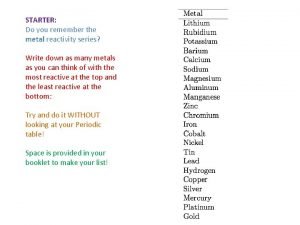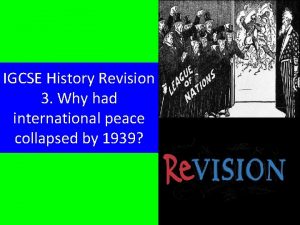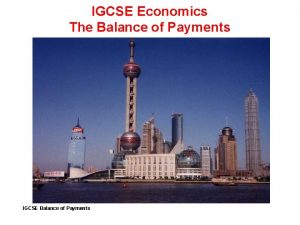IGCSE History Revision 7 Why did events in
















































































- Slides: 80

IGCSE History Revision 7. Why did events in the Gulf matter, c. 1970 -2000?

Key Points Ø Saddam Hussein’s rise to power including the influence of Khairallah Tulfah and Ahmad Hasan al-Bakr. Ø The nature of Saddam Hussein’s rule in Iraq between 1979 and 2000. Ø The nature of the Shah’s rule in Iran and the reasons for the Iranian Revolution of the 1979. Ø The causes and consequences of the Iran-Iraq War 1980 -8, and the reasons for Western involvement in the war. Ø The Causes course and consequences of the First Gulf War of 1990 -1.

Revision Tips 1) You will need to have a good understanding of how Saddam Hussein became President of Iraq despite having a few advantages of education and upbringing. The influence and support of family relatives is central to his understanding. You must also appreciate Saddam Hussein’s individual skills. Once a prominent politician, his cunning, outmaneuvering of rivals, and ingratiation with superiors became the essential means of achieving the presidency.

Revision Tips 2) For the nature of Saddam Hussein’s rule up to 2000 you must become familiar with the key features of his rule such as terror and repression, war against his own people, and ways of boosting popular support through social reforms and propaganda. 3) Understanding the reasons for the Iranian Revolution of 1979 involves looking at the nature of the Shah’s rule together with the counter attractions of the various opposition groups led by the charismatic Ayatollah Khomeini. You need to be able to identify the mistakes impacted upon the population of Iran.

Revision Tips 4) You must become familiar with the main causes of the Iran-Iraq War, especially the territorial disputes and religious differences. You must also appreciate that, despite the rhetoric of Saddam Hussein, the war did little but impoverish the two participants. 5) Similarly you require a clear understanding of the reasons for Saddam Hussein’s invasion of Kuwait in August 1990 – financial, strategic, and domestic. Why did he think that he would get away with it? Why was the war over so quickly and how did the defeat affect the future of Saddam Hussein’s regime?

The Rise of Saddam Hussein

Rise of Saddam • When he was 20 years old, Saddam Hussein joined the Ba’ath Party, whose ultimate aim was to unite all the Arab states in the Middle East. This ideology is known as Arab Nationalism, and to an extent it drove Saddam’s early actions. Having failed in 1959 to assassinate a previous President who opposed Arab Nationalism, Saddam was one of the leading figures in a bloodless but successful Ba'athist coup in 1968. The coup led to Ahmed Hassan al-Bakr becoming Iraq's president, while Saddam was appointed as his Vice-President.

Rise of Saddam • To understand how Saddam moved from the position of Vice-President to President, it’s important to have a good understanding of how he built and consolidated his power during the 1970 s. This part of the syllabus focuses on the reasons for Saddam’s rise to power, and so to do well you need to be able to explain a range of different factors. Similar to other dictators you may have studied, Saddam combined different policies to secure his position. His ruthless systems of terror and repression ran alongside social and economic policies that gained him a lot of popular support. You need to be able to give specific and detailed examples of each, and that’s what this podcast will help you with.

Rise of Saddam • It’s firstly important to remember that Saddam could not have successfully implemented any policies as Vice-President without first establishing a strong power base within government. He did this by ensuring that the most important positions in the government and military were given to his friends and relatives from his hometown in the area of Tikrit. To keep the army on his side, Saddam also provided them with a large defense budget to enable them to buy and develop modern weapons – including chemical weapons.

Rise of Saddam • To ensure the population did not oppose the ruling Ba’ath Party, various parts of Iraqi society were brought under its control, and membership of important clubs and institutions was usually decided based on whether you were a member of the party or not. However, Saddam didn’t only secure support through underhand means. He oversaw the nationalization – or government takeover – of Iraq’s oil industry in 1972, which led to a dramatic improvement in the economy. Just a year later, in 1973, Iraq joined with the other Arab oil-producing states in OPEC (an international organization that coordinates petroleum policy) to reduce production and – in some cases – stop exports of oil to Western countries as punishment for supporting Israel in the Yom Kippur war. The subsequent shortage of oil pushed up the price of a barrel of oil by 400 per cent, meaning that Iraq’s income rocketed.

Rise of Saddam • A lot of the money now flooding into the Iraqi economy was used by Saddam to invest in the country’s infrastructure. The country’s road, water and power infrastructure benefited from a significant increase in spending, but the most notable spending was on education and healthcare. The government’s establishment of free universal education meant that hundreds of thousands of Iraqis were educated to unprecedented levels in the years that followed the establishment of the “National Campaign for the Eradication of Illiteracy”. Furthermore, enormous investment in healthcare meant that Iraq had one of the best healthcare systems in the Middle East, for which Saddam was presented with an award by UNESCO. Iraq was modernizing at a dramatic pace, and by the end of the 1970 s the number of Iraqis who were rural peasants had declined significantly as people moved to the modern cities. The level of investment that directly impacted ordinary Iraqis won Saddam huge popular support, and also ensured that he had the backing of the new class of businessmen who worked within the industries that were being developed.

Rise of Saddam • However, behind the social improvements and political maneuvering there was a violent system of repression. Saddam played a major role in creating a state security apparatus that kept a close watch on the Iraqi population. The People’s Army was responsible for internal security, although it was actually the paramilitary wing of the Ba’ath Party. Consequently they were able to ensure that other elements of the Iraqi military were unable to oppose the government. Furthermore, anybody who disagreed with the party would find themselves arrested by the secret police – known as the Department of General Intelligence or the Mukhabarat – that frequently used torture, rape and assassination to intimidate and remove enemies of the state. Saddam’s control over the appointment of positions in the security services also meant that the recruits were supporters of him as an individual, meaning that by the time the President resigned in 1979 the only feasible replacement was Saddam himself.

Rise of Saddam • It’s important to remember that Saddam Hussein did not become President of Iraq for just one reason. His influence within the Ba’ath party, support from the population, and his use of terror and repression against enemies, all contributed in one way or another. To do well in the exam, you need to be able to give specific examples for each of these factors and explain how each one affected his rise to power.

Saddam’s Rule

Saddam’s Rule • You will remember that Saddam was able to come to power for three key reasons: his dominance of government, a series of social and economic policies that benefited the vast majority of Iraqis, and a ruthless system of terror and repression that dealt with anyone who dared to oppose him. He continued this general style of rule as President, but his use of fear and violence to maintain his position increased significantly. The strength of the Ba’ath Party was also central to his position, and he acted quickly to ensure that he would not face any opposition. Within a week of becoming President, Saddam ordered a meeting of Ba’ath Party members in which he claimed he had identified 68 traitors. These members were quickly removed, tried for treason, and executed. By the start of August, hundreds more had been killed. Therefore, from the very moment he became President, Saddam ensured that people who were a threat to his position were removed.

Saddam’s Rule • For many ordinary citizens, however, Iraq’s strong economy meant that they experienced a good quality of life under Saddam. Much as he had done during his rise to power, Saddam continued to plough money into improving and modernizing the infrastructure of Iraq. Education and healthcare remained high on the spending budget, with university education being made free. Across the country, improvements to electricity and water supplies, and an improved road network secured Saddam the support of swathes of Iraqi citizens. In the 1995 election, for example, the official results showed that Saddam received over 99% of the vote.

Saddam’s Rule • His popularity was helped by propaganda. When Egypt signed the Camp David Accords with Israel, Saddam used the so-called betrayal of the Arab world to his advantage. Iraqi media presented him as the saviour of pan-Arabism, while his cult of personality was reinforced by the erection of statues of him all over the country. Although the education system was free, it indoctrinated people with ideas that benefited Saddam. Even the way he encouraged people to refer to him by his first name rather than his surname, as is usually the case with political leaders, helped in some way to present Saddam as a father figure to his people, rather than as a vicious dictator.

Saddam’s Rule • But however good the situation appeared to be, the reality was that violence and fear were central tools in maintaining Saddam’s power. From the outside Saddam’s policies of freedom or religion were the hallmarks of a developed nation. However, his violent repression of Shiite Muslims and Kurds proved this to be an illusion. Although Shiite Muslims were the majority religious group in Iraq, Saddam was a Sunni Muslim and consequently saw them as a threat to his power. Saddam had already ensured that his government was a Sunni majority. Removing threats was key to his rule, and so deportations of those he could not trust were common. Consequently an estimated 200, 000 Shiites were sent to neighboring Iran in 1980 - 81 alone. Many more were monitored, arrested, and tortured if the internal security forces thought they were a threat to Saddam.

Saddam’s Rule • Although the repression of Shiite Iraqis affected many hundreds of thousands of people, the Kurd minority in Northern Iraq suffered even more. Whereas the threat from the Shiites came from their desire to become more involved in Iraqi government and society, the Kurds were a threat to Saddam’s power because they wanted to separate from Iraq and create their own country called Kurdistan. Saddam was determined to extend his government’s hold over all areas within Iraq, and this directly impacted the Kurds who had previously been left with a certain amount of freedom from the Iraqi government to govern themselves.

Saddam’s Rule • Beginning during his Vice-Presidency, Saddam launched a series of attacks against the Kurds that exiled or killed their leading figures. However, Saddam’s hatred of the Kurds reached a boiling point after the separatists sided with Iran in the Iran-Iraq War. As part of the conflict, Saddam ordered the bombing of the Kurdish town of Halabja in 1988. While this in itself was not unexpected, the attack included the use of chemical weapons such as mustard gas and cyanide. 5, 000 Kurds were killed, and a further 10, 000 seriously injured. This added to the existing attacks on the Kurdish nationalist movement that had been masterminded by Saddam’s cousin, nicknamed Chemical Ali. As well as the chemical attacks, he bulldozed entire villages and conducted mass executions. The destruction of the Kurdish north was vicious, with somewhere in the region of 150, 000 Kurds killed and a further 100, 000 fleeing to nearby Turkey.

Saddam’s Rule • The level of violence that Saddam was willing to use against his own people was a key reason that he was able to maintain his hold on power, as few were prepared to stand up to him. However, it’s important that when assessing Saddam’s rule you consider both his repression of enemies and reasons why people actively supported him. If you are asked how far terror was responsible for his hold on power, you must be able to give evidence on both sides of the argument.

Why was there a revolution in Iran in 1979?

Iranian Revolution • Today, Iran is vastly different to how it was in 1979. Iran is now a theocracy – a country ruled by religious leaders – which could suggest that the revolution that brought the Ayatollah Khomeini to power was a conservative religious backlash against the ruler, Mohammad Reza Shah Pahlavi. However, as with most things in history, it’s not quite that simple. Whether you are explaining why the revolution occurred, or judging how far a particular reason was responsible, you need to be able to give examples of a range of different factors. This podcast aims to give examples of a range of different factors that contributed to the Iranian Revolution of 1979 including the effect of anti-Western feeling, widespread social and economic inequality, and the impact of Ayatollah Khomeini.

Iranian Revolution • By the middle of the 20 th century, Iran was a country that enjoyed immense wealth built on an abundant supply of oil even though the vast majority of the population continued to live in poverty. Iran’s ruler, Mohamed Reza Shah Pahlavi, had come to power in 1941 after his father was removed from power by a combined force of British and Russian troops and maintained a close relationship with the Western powers including the USA. This relationship was severely tested when, in 1951, his Prime Minister Mohammad Mussadiq nationalised the Britishowned Anglo-Iranian Oil Company that had controlled the oil fields. The move proved hugely popular with ordinary Iranians, but caused enormous problems with the Western powers who now refused to buy Iran’s oil since they were no longer in control of it. This response led the Shah to plot remove Mussadiq, using the expertise of the American CIA and the British MI 6.

Iranian Revolution • Although the coup restored relations with the West and led to Iran growing very rich from the oil industry, many Iranians saw the move as a betrayal of Iranian sovereignty and as pandering to the Western powers. This feeling was reinforced when, in 1956, the Shah joined an anti-Soviet (and therefore anti-Communist) alliance. The USA had signed a treaty with Iran the previous year, and it was now clear that Iran was taking sides in the Cold War. The Shah’s close relationship with the West was therefore one of the long- term factors that caused the Revolution of 1979, because many in the country felt that he was betraying Iran.

Iranian Revolution • To try to win support, the Shah used the income from the new National Iranian Oil Company to modernize Iran. He began to introduce a series of reforms known as the ‘White Revolution’ from 1962 onwards, in an attempt to improve the social and economic situation for most Iranians. For example land reforms allowed peasants to purchase land; women were given the right to vote; the Literacy Corps was introduced to teach people in the rural areas how to read and write. However, such policies were interpreted by some as the effect of the Shah’s close relationship with the West.

Iranian Revolution • Iran was also becoming a huge market for American grain and meat, which often meant that local farmers were put of business. As a result many young people moved to the cities to look for work, but found that there weren’t enough jobs. Furthermore, industrial reforms meant that foreign investment was ploughed in to creating modern factories that put smaller producers and local shops out of business. To many people in Iran, it seemed as though the Shah was changing Iran for the worse by introducing ideas that went against Iranian tradition and that were not for the benefit of the people.

Iranian Revolution • The Shah himself was aware of the opposition he faced. He had only managed to remove Mossadeq with the help of foreign intervention, but had become the target of a number of assassination attempts. To protect himself, he would often ignore the constitution and introduce policies that further alienated him from the people. In 1957, for example, he established his own secret police called the SAVAK. Their methods were brutal, using torture and execution to intimidate and silence political opponents that led to the people of Iran living in constant fear. Consequently the opposition were silenced, although a growing number of Iranians were turning against the Shah.

Iranian Revolution • Despite the ban on political parties in Iran, the opposition was able to find a leader in the Muslim scholar, Ayatollah Khomeini. Muslim religious leaders, known as mullahs, used the mosques and weekly Friday prayers to speak out against the Shah’s regime. They criticized the Shah’s support of the state of Israel, and encouraged attacks on cinemas that showed foreign, often sexualized, films that were felt to be un-Islamic. In particular they criticized the wealth and luxury of his lifestyle, in a country where many people struggled to afford to eat.

Iranian Revolution • The enormous gap between the rich and poor was demonstrated when Shah held a huge threeday party to celebrate the 2, 500 th anniversary of the founding of the Persian Empire in October 1971. Officially, the Shah claimed the event cost $40 million but it’s likely that the real cost was well over $100 million. As American journalist Robin B. Wright said in 2000, “As the foreigners reveled on drink forbidden by Islam, Iranians were not only excluded from the festivities, some were starving. ”

Iranian Revolution • By this point, Ayatollah Khomeini had already been criticizing the Shah’s “Western decadence” at the cost of Iran’s Islamic heritage for a decade. In 1964 this led to him being forced into exile in France, from where he continued to speak out against the Shah’s government. His speeches were recorded onto cassette tapes and smuggled into Iran, where they were copied and distributed. Just like Twitter or Facebook, these cassettes helped Khomeini to broadcast his message to people even though he wasn’t there in person.

Iranian Revolution • As a religious cleric, he automatically received a lot of respect from religious Iranians, and his simple language appealed to the people who were poor or unemployed. Due to his sizeable following, many members of the opposition recognized that Khomeini was best positioned to lead the movement against the Shah. He played down his desire to establish an Islamic government in Iran, concentrating instead on working with the different opposition groups to overthrow the Shah.

Iranian Revolution • By 1978, the Shah’s various opponents had begun to publicly demonstrate against the Shah, and the situation in the capital city of Tehran became increasingly volatile. When, on September 8 the 1978, the Shah imposed martial law –that’s military rule – the opposition responded with a huge protest in the city’s Jaleh Square. More than 500 people were killed by soldiers, in what became known as ‘Black Friday’. Although the Shah condemned the killings, Black Friday led to even more demonstrations with people calling for the death of the Shah.

Iranian Revolution • He attempted to calm the people by giving more political freedoms and releasing political prisoners. This had no effect on the people, who continued to call for the removal of the Shah, along with an increasing number of soldiers who sympathized with the protesters. On December 11, 1978, another huge demonstration called for Ayatollah Khomeini to return to Iran and lead the revolution. Recognizing that his overthrow was becoming inevitable, the Shah and his wife left Iran on January 16, 1979 to receive treatment for cancer. They never returned.

Iranian Revolution • Left in charge of the crumbling regime, the Shah’s last Prime Minister attempt to block Khomeini from returning by closing the main airport. Despite this, Khomeini left France on a specially chartered flight and landed in Iran on February 1, 1979, with a coalition of Khomeini and other opposition leaders taking power ten days later on February 11.

Iranian Revolution • Khomeini’s supporters went on to dominate the new government. Here, they purged Iran of perceived un-Islamic influences and introduced laws based on the Holy Quran. As well as becoming an Islamic theocracy, Iran became more and more anti-Western, and particularly anti-American. In November 1979 students stormed that American embassy in Tehran in protest at America allowing the Shah into the country for medical treatment.

Iranian Revolution • However, it’s important to remember that the Iranian Revolution itself was more than a religious uprising. It’s true that Ayatollah Khomeini was the leading opposition personality during the final months of the Shah’s rule, but he was not the only cause. Long-term dissatisfaction with the Shah’s government and his handling of the economic and social problems in Iran had led to enormous discontent, which was amplified by a widespread anti- Western attitude as a result of the Shah’s close relationship with Britain and the USA. You need to be able to give examples of each of these in order to explain why there was a revolution in Iran in 1979.

Causes and Consequences of the Iran-Iraq War, 1980 -88

Iran-Iraq War • When the Iraqi President, Saddam Hussein, declared war on Iran in September 1980 he dubbed it the ‘Whirlwind War’ in which he expected Iran to be defeated relatively swiftly. However the war persisted for nearly 8 long and bloody years, with an estimated half a million soldiers killed – and an equivalent number of civilians. This podcast will focus on three key issues: firstly the different causes of the war, then the nature of how it was fought, and finally consequences of the war for each nation.

Iran-Iraq War • Having secured the Presidency of Iraq in 1979, Saddam Hussein was keen to consolidate the power of his minority Sunni Muslin Ba’ath government. However, at almost exactly the same time, Ayatollah Khomeini came to power through the Iranian Revolution, installing a Shi’ite Muslim theocracy in Iraq’s neighbor.

Iran-Iraq War • One of the key causes of the war was that, shortly after the revolution, Ayatollah Khomeini called for the overthrow of Saddam’s Ba’athist regime in Iraq. Unsurprisingly, this was met with hostility in Iraq, especially after Shia militants assassinated 20 party officials in April 1980. This devastating attack built upon previous localized uprisings against the Ba’ath party, which the government believed had been supported and encouraged by Iran.

Iran-Iraq War • The war wasn’t just an attempt to stop Iran’s threatening behavior, however. Both countries relied on oil exports to generate the vast majority of their national income, but Iran’s extensive access to the Persian Gulf vastly outstripped Iraq’s tiny coastline. A particularly sore point for Iraq was Iranian access to the Shatt Al-Arab waterway, which Iraq had reluctantly allowed Iran to use in the Algiers Agreement of 1975. A second cause of the war was therefore Iraq’s need to push Iran back and take complete control of the waterway to secure their own oil exports. If the army was successful, they could even increase their oil reserves by capturing some of Iran’s oil fields in the surrounding areas.

Iran-Iraq War • Saddam knew that achieving these aims through a short and decisive war against Iran would expand Iraq’s influence, power and prestige in the Middle East. However, timing was critical. The third reason Saddam therefore began the war in September 1980 was because Iran was poorly prepared for war at the time. Its army had recently been purged of officers and soldiers loyal to the former Shah, and so was militarily weak and demoralized. Furthermore, the country’s economy was in tatters as a result of western countries boycotting trade due to the ongoing hostage crisis at the American Embassy.

Iran-Iraq War • In order to answer the key questions on the exam, you need to be able to explain these three key reasons for the outbreak of the war. Whether you are looking at an ‘explain why’ question about the causes of the war, or whether you are looking at an analytical question in which you assess how important a particular factor was, you must be able to give a range of reasons for the war. Remember the key points: Iran’s threat to Saddam’s regime, the opportunity to gain territory and oil, and timing. You need to provide evidence for each point, and explain why they contributed to the war. Point, Evidence, Explanation.

Iran-Iraq War • The Iran-Iraq war raged for an unprecedented 8 years, making it the longest Middle Eastern war in the 20 th Century. Despite Saddam’s expectations of a quick and easy victory, Iran mobilized its revolutionary population who voluntarily streamed to the front lines and pushed the Iraqis back to their own border. Additionally, Iran’s superior navy deployed into the Persian Gulf and blockaded Iraq’s ports – meaning that Iraq was unable to export any of its oil, or import badlyneeded supplies.

Iran-Iraq War • Of the major foreign nations that were involved in the Iran-Iraq war, only Syria sided with Iran. The issue was more a case of ‘my enemy’s enemy is my friend’ because of Syria’s rivalry with Iraq. Their most significant contribution to the Iranian war effort was shutting off Iraq’s main oil pipeline that ran from the oil fields of Kirkuk to the Syrian port of Baniyas on the Mediterranean. The closure of the pipeline is estimated to have cost Iraq $5 billion per month, which would have made the war impossible to continue if it wasn’t foreign support for Iraq.

Iran-Iraq War • The role of other foreign powers was therefore crucial to maintaining Iraq’s war effort, with virtually the entire Arab world throwing its support behind Iraq. Saudi Arabia, Egypt, Jordan, Kuwait, Qatar, Bahrain, and the United Arab Emirates all contributed money and weapons to the Iraqi war effort. Jordan’s land border with Iraq was also vitally important as it provided a route for imports and exports that avoided the blockaded Persian Gulf.

Iran-Iraq War • Beyond the Arab states, France and the USSR became the biggest suppliers of arms to Iraq. Amazingly, considering the ongoing Cold War and the fact the Soviet Union was already supporting Iraq, the USA also came in on the side of Saddam by providing intelligence information from their satellites. They also provided naval escorts through the blockaded Persian Gulf to get Iraqi imports and exports moving again.

Iran-Iraq War • The Iran-Iraq war finally came to an end on July 20 th 1988, when a ceasefire known as UN Resolution 598 was universally approved. Ever since the earliest weeks of the war, attacks on civilians had been a major part of the tactics of both sides, known as the ‘War of the Cities’. In the final months of the war these attacks became more and more brutal, with Iran fearing an all-out chemical attack against their cities when an estimated 2, 000 civilians were killed after Iraqi planes dropped poison on the north-western town of Oshnavieh. When even more civilians died after cyanide and other poisonous gases were dropped at the start of July, Ayatollah Khomeini reluctantly accepted the UN ceasefire.

Iran-Iraq War • The consequences of the war were, in many ways, similar for both Iran and Iraq. Primarily, neither country had succeeded in its primary aim of a military defeat of the other. Indeed, most historians and military analysts say that the entire 8 -year conflict was a stalemate by returning the two countries to their pre-war position. The economies of both nations had also been destroyed as a result of damage to their oil infrastructure and the expense of the war. Each side had spent an estimated $500 billion on the war, and the war had slowed their economic development to such an extent that recovery was significantly affected.

Iran-Iraq War • In an Iranian radio broadcast announcing the ceasefire, Ayatollah Khomeini expressed unhappiness at having “drunk the poison chalice” by approving the truce. However, his reputation survived intact, Iran maintained its Shi’ite theocracy, and his funeral a year later was attended by 12 million people.

Iran-Iraq War • In Iraq, meanwhile, support for the government declined. Despite the extensive systems of control and terror wielded by Saddam, riots and strikes occurred throughout the country. A key problem was that the army, who had previously been used to repress opposition, was itself upset at the outcome of the war. Some soldiers blamed Saddam himself for the failure to defeat Iran, and a number of suspected traitors were executed in the years that followed.

Iran-Iraq War • The effect on the civilian population was also significant. The cost of the war had used up funds previously allocated to social welfare, education and healthcare, resulting in an increase in infant mortality and reduction in life expectancy. Despite promises to improve the situation after the war and Iraq’s eye-watering debts of over $130 billion, Saddam continued to invest heavily in weapons that he later used in his invasion of Kuwait in 1990.

Iran-Iraq War • The overall impact of the war on both countries was catastrophic. If you are asked about the consequences of the conflict, you could say that in many ways both Iran and Iraq experienced the same devastating economic and social effects, and give specific examples relating to each country. However, whereas the Iranian government managed to maintain its popular support, the people of Iraq had begun to question their leadership.

Origins of the First Gulf War

First Gulf War • The trigger for the Gulf War was Iraq invasion of Kuwait on the 2 nd August, 1990. However, its origins can be traced back many years to the period of British control of the Middle East. Iraq and Kuwait had both been ruled by Britain for nearly half a century. When they left Kuwait in 1961, Iraq immediately claimed control but was forced to recognize Kuwait’s independence in 1963.

First Gulf War • This long-term tension lay simmering under the surface for many years, yet began to seep out into the open following the Iran-Iraq War. To fund the war effort, Saddam Hussein had been forced to borrow $80 billion from allies and neighbors, so was left with crippling debts. $14 billion dollars of this money was owed to its small neighbor Kuwait.

First Gulf War • The post-war economy did little assist Iraq’s economic recovery as the worldwide price of oil was low due to an oversupply. This meant that Iraq’s economy, which relied on oil exports, suffered significantly, with some economists calculating that Iraq lost up to $14 billion a year between 1985 and 1989. Iraq had tried to get the OPEC, who controlled oil production, to reduce production in order to try to increase prices but they refused. Saddam accused Kuwait and the United Arab Emirates of producing more than their quota and consequently lowering the global price of oil due to oversupply. Furthermore, Saddam accused Kuwait of so called ‘slant-drilling’ to steal oil from the Iraqi-controlled portion of the Rumalia oil field that lay on their shared border.

First Gulf War • Although diplomatic talks between Iraq and Kuwait began in July 1990, during which Kuwait promised to reduce their production, the talks soon broke down. Later that month Saddam met with April Glaspie, the United States Ambassador to Iraq, where she told the Iraqi leader that the USA had no interest in the Iraq-Kuwait dispute and would not get involved. This effectively gave Saddam the green light to invade, although a last-ditch attempt to reach an agreement took place on August 1 st when representatives from the two nations met in Saudi Arabia. Iraq demanded that Kuwait pay $10 billion in compensation for lost revenues but Kuwait offered $9 billion. This again failed to resolve the dispute, and Iraq invaded Kuwait the next day on the 2 nd August 1990.

First Gulf War • Shortly after midnight on the 2 nd August, the Iraqi invasion began when approximately 300, 000 military personnel began moving in to Kuwait to take on their comparatively tiny military of 16, 000 men. Despite months of threats from Iraq, the invasion still caught the Kuwaitis by surprise and Kuwait City had fallen under Iraqi control by the end of the day. Another two days of fighting defeated the remaining military resistance, with surviving Kuwaiti forces and military equipment evacuated to neighboring Saudi Arabia and Bahrain. Saddam installed a puppet government to rule Kuwait before annexing it to Iraq. Unwilling to live under Iraqi rule, approximately 400, 000 Kuwaitis and thousands of other foreign nationals fled the country. India alone flew 488 flights over a twomonth period to evacuate almost 112, 000 Indian civilians, making it the largest civilian evacuation in history.

First Gulf War • The invasion of Kuwait was the catalyst for the Gulf War that began a few months later. However, it’s important to remember that the invasion of Kuwait was not the Gulf War. A question might focus on one or both of these events, so you need to remember that the invasion of Kuwait was a cause of the Gulf War but that the invasion of Kuwait had its own causes. • International condemnation of the invasion of Kuwait was immediate and far-reaching. Even France, which had traditionally been on good terms with Iraq, called for Saddam to withdraw his forces. The United Nations Security Council passed a resolution condemning the invasion, and the Arab League similarly passed a resolution calling for the Iraqi withdrawal from Kuwait.

First Gulf War • A few days later, when it became clear that Saddam was not going to remove his troops, further resolutions were passed by the UN. Resolutions 661 and 665 put in place complete economic sanctions against Iraq and also authorized a naval blockade to enforce the sanctions and stop Iraq trading with any other country.

First Gulf War • In response, Saddam said that he would withdraw his troops from Kuwait as long as Israel withdrew from occupied territories in Palestine, Syria and Lebanon. This won Saddam support from the Palestinian leader Yasser Arafat, but did little to improve the situation. By linking the occupation of Kuwait to the Arab-Israeli conflict, Saddam also hardened American attitudes against Iraq. Reports of thousands of Kuwaiti civilians being arrested, tortured and executed – often in front of their own families – by Iraqi troops brought more condemnation. Additionally, Saddam refused to allow remaining foreigners in Kuwait to leave. This further angered the international community, especially after a British boy was shown as one of the hostages as part of television propaganda.

First Gulf War • In addition to all these causes for international concern, Iraq’s occupation of Kuwait also threatened the international economy. Iraq already controlled significant amounts of the world’s oil, and the invasion of Kuwait gave it access to more. With Iraqi troops just a few miles away from Kuwait’s border with Saudi Arabia, America in particular became concerned that Saddam might invade and seize control of the Saudi oil fields as well. This would have put more than half of the world’s oil fields under Iraqi control.

First Gulf War • Over a decade before, on the 23 rd January 1980, American President Jimmy Carter announced a policy of using military force to defend its national interests in the Persian Gulf. Although originally a Cold War warning to the Soviet Union, the Carter Doctrine was implemented by President George Bush when he approved a mission to prevent Iraq invading Saudi Arabia. Operation Desert Shield began on the 7 th August, just a few days after the invasion of Kuwait, and provided the backbone for the international coalition against Iraq.

First Gulf War • On 29 November 1990 the UN Security Council passed Resolution 678, which gave Iraq an ultimatum. If Iraqi troops did not withdraw from Kuwait by the 15 th January 1991, military force would be used against them. US Secretary of State James Baker visited a number of countries to ensure support for a multi-national force, and succeeded in securing troops and money from both Western and Arab countries. Although some of the nations were reluctant, 34 separate countries joined the coalition that was to be commanded by U. S. Army General Norman Schwarzkopf, Jr.

First Gulf War • In an exam you may be asked to explain why so many countries were willing to join together to fight against Iraq. A desire to protect the world’s oil supplies was certainly a significant factor.

The First Gulf War: Course and Consequences

First Gulf War • On the 29 th November 1990 the UN had given Iraq an ultimatum: withdraw from Kuwait by the 15 th January 1991 or face military force. As the UN’s deadline to withdraw approached, Saddam refused to withdraw from Kuwait. Consequently the combat phase of the First Gulf War, known as Operation Desert Storm, began shortly after midnight on the 17 th January. Just a few hours later, Saddam Hussein appeared on state radio saying that "The great duel, the mother of all battles has begun. The dawn of victory nears as this great showdown begins. " He couldn’t have been more wrong. Following five weeks of aerial bombardment, the Coalition’s ground assault forced the Iraqi troops from Kuwait in just four days.

First Gulf War • The Desert Storm aerial bombing campaign saw over 2, 250 Coalition aircraft fly in excess of 1, 000 sorties a day for five weeks. Seeking to destroy key military targets and disrupt civilian infrastructure, live footage of the campaign was broadcast around the world on satellite TV. Having virtually destroyed Iraq’s air force and anti-aircraft defenses, the Coalition quickly established air supremacy. A veteran Iraqi soldier from the Iran–Iraq War even commented that his brigade had suffered more damage from the coalition air force than from "eight years of fighting against Iran. "

First Gulf War • Saddam hoped in vain that the level of destruction caused by the Coalition’s vastly superior air force would result in world opinion turning against them. Finding that this didn’t happen, he instead tried to break up the Western-Arab Coalition by launching Scud missile attacks on Israel was not a part of the coalition, but if it was to join the war its involvement would have made continued Arab support difficult. In the event, however, Israel was convinced by the United States not to respond to the missile strikes and the Coalition held together.

First Gulf War • By the time the Coalition launched its full-scale ground attack on the 24 th February, Iraq was therefore at a significant disadvantage. Although a number of smaller missions had already demonstrated that Iraq’s dated military equipment and poorly-trained army was no match for the Coalition forces, U. S. generals were still surprised at the speed of their advance. An estimated 10, 000 Iraqi prisoners were taken on the first day.

First Gulf War • On the 27 th February, Saddam Hussein called a retreat from Kuwait. Some Iraqi troops continued to engage in fierce fighting at Kuwait International Airport, but by the following day United States President George Bush had declared Kuwait liberated. As they retreated from Kuwait, however, Iraqi forces employed a scorched earth policy that saw them set fire to almost 700 Kuwaiti oil wells and place land mines around the oil fields in the hope of making it more difficult to extinguish the fires.

First Gulf War • On the 28 th February President Bush called for a ceasefire. While this was being negotiated, a series of uprisings began in both northern and southern Iraq against Saddam’s rule. America hoped that the uprisings would lead to an internal coup d’e tat that would overthrow Saddam, and so the rebellions by Kurds in the north and the Shi’ites in the south were encouraged by the American government. However, they received no physical US support in terms of troops or equipment and were ruthlessly crushed by Saddam’s loyal generals and this led to a humanitarian crisis that was only solved when the Coalition introduced no-fly zones to protect civilians from Iraqi attacks that led to the establishment of the Kurdistan Regional Government.

First Gulf War • The ceasefire was imposed by the United Nations. Alongside other terms, Iraq had to recognize Kuwaiti sovereignty and pay reparations for the damage caused during the war. Furthermore, a series of punishing trade sanctions were imposed on Iraq while UN weapons inspectors searched for and destroyed Weapons of Mass Destruction including biological, chemical and nuclear weapons.

First Gulf War • The sanctions prevented the import of a huge range of items ranging from machinery to medicines and books. The country was only able to sell very limited amounts of oil which had a direct impact on its ability to buy those few items it could import. Furthermore, a ban on the importation of chemicals such as chlorine – which could be used to make WMDs but is also used to purify water – led to outbreaks of dysentery as a result of drinking contaminated water. Up to half a million children died as a result of hunger and disease, with 7, 000 dying every month by 1997. The ‘Oil for Food’ programme was therefore introduced by the UN in 1996 and went some way to solve the humanitarian crisis.

First Gulf War • The decision to call a ceasefire rather than to push on to Baghdad and remove Saddam from power was heavily criticized by some in the American government. However, such action risked fracturing the Coalition since its UNsanctioned mission only went as far as liberating Kuwait. With this objective met, American troops began to leave the Gulf area on the 10 th March.

First Gulf War • The search for Weapons of Mass Destruction was conducted by the United Nations Special Committee, known as UNSCOM. Iraq cooperated with the weapons inspectors due to the devastating effects of the sanctions and admitted to stockpiling a range of weapons including nerve gas and chemical warheads. Furthermore the inspectors found enriched uranium that could be used to manufacture nuclear weapons.

First Gulf War • It took three years for UNSCOM to destroy the materials that Iraq could use to manufacture WMDs, and to remove all medium- and long-range missiles. Sanctions were having a huge effect on the living conditions of ordinary Iraqis, and the government was keen to have them lifted. However, they failed to provide proof that they had destroyed stocks of anthrax and nerve gas themselves. Coupled with the defection of Saddam’s son-in-law who claimed that Saddam had ordered WMDs be hidden, the United States were unwilling to lift the sanctions unless Saddam was removed from power.

First Gulf War • Despite the devastating effects of the economic sanctions, Saddam maintained control of the country. He continued to use violence and terror to control his enemies, and rewarded those who remained loyal to him. You can find out more about these systems of control and how they affected life in Saddam’s Iraq in a separate podcast. Meanwhile he sought sympathy from the rest of the Arab world by filming and broadcasting the suffering of Iraqi people that had been brought on as a result of the sanctions. After he expelled the UN weapons inspectors in 1997, America and Britain responded with airstrikes against military sites. The bombing campaign and the ongoing sanctions won him further support, and by the year 2000 he had restored diplomatic relations with neighboring countries. The First Gulf War had shown Saddam that he was unable to match the world’s military might, but he had stayed in power.
 Igcse english paper 1 tips
Igcse english paper 1 tips Igcse ict theory
Igcse ict theory Ict igcse theory revision presentation
Ict igcse theory revision presentation Ict igcse theory revision presentation
Ict igcse theory revision presentation Igcse ict
Igcse ict Ict igcse practical revision presentation
Ict igcse practical revision presentation Ict igcse theory revision presentation
Ict igcse theory revision presentation Pictures
Pictures Revision passive voice
Revision passive voice Igcse history chapter 6
Igcse history chapter 6 History edexcel gcse past papers
History edexcel gcse past papers Mutually exclusive vs non mutually exclusive
Mutually exclusive vs non mutually exclusive How to measure business success igcse
How to measure business success igcse Ocr gcse modern world history revision guide
Ocr gcse modern world history revision guide Don't ask why why why
Don't ask why why why Julius caesar chronological order
Julius caesar chronological order Bell ringer response sheet
Bell ringer response sheet Also history physical
Also history physical Young and dyslexic structure analysis
Young and dyslexic structure analysis What is a sphere of influence geography
What is a sphere of influence geography Night analysis igcse
Night analysis igcse Igcse cambridge livelli
Igcse cambridge livelli Nature of formative assessment
Nature of formative assessment Introduction of marriage
Introduction of marriage Types of energy igcse
Types of energy igcse Young and dyslexic igcse analysis
Young and dyslexic igcse analysis Dr frost sketching quadratics
Dr frost sketching quadratics What is igcse
What is igcse Igcse poems 2021
Igcse poems 2021 Igcse
Igcse Igcse ict chapter 5
Igcse ict chapter 5 Whats oxygen debt
Whats oxygen debt Energy flow diagram physics
Energy flow diagram physics Jules to volts
Jules to volts Electricity igcse physics edexcel
Electricity igcse physics edexcel Edexcel igcse physics
Edexcel igcse physics Edexcel igcse physics movement and position questions
Edexcel igcse physics movement and position questions P=f/a
P=f/a Edexcel igcse computer science
Edexcel igcse computer science English literature past papers edexcel
English literature past papers edexcel English language igcse paper 1
English language igcse paper 1 Force igcse
Force igcse Freezeray physics
Freezeray physics Straight lines and quadratic equations igcse
Straight lines and quadratic equations igcse Between a rock and a hard place igcse
Between a rock and a hard place igcse Significant cigarettes
Significant cigarettes Igcse poems 2021
Igcse poems 2021 Igcse geography case study questions
Igcse geography case study questions Assonance in mid term break
Assonance in mid term break How to measure business success igcse
How to measure business success igcse Igcse teacher training
Igcse teacher training Igcse
Igcse Dr j frost
Dr j frost English as a second language igcse syllabus
English as a second language igcse syllabus Market research igcse
Market research igcse Igcse spanish speaking questions
Igcse spanish speaking questions Astronomy igcse
Astronomy igcse Half life definition igcse
Half life definition igcse Imaginative writing edexcel igcse
Imaginative writing edexcel igcse Chemistry syllabus 0620
Chemistry syllabus 0620 Touchscreen input or output
Touchscreen input or output Tropism igcse biology
Tropism igcse biology Igcse paper 2
Igcse paper 2 Language
Language Quantitative chemistry igcse
Quantitative chemistry igcse Igcse
Igcse Certificazione igcse a cosa serve
Certificazione igcse a cosa serve Igcse program
Igcse program Igcse
Igcse Business activity igcse
Business activity igcse Igcse
Igcse Igcse
Igcse The bright lights of sarajevo
The bright lights of sarajevo Reactivity series class 10 mnemonic
Reactivity series class 10 mnemonic Igcse
Igcse Igcse tips
Igcse tips Current ratio adalah
Current ratio adalah Igcse
Igcse Percy spencer the inventor of the microwave oven igcse
Percy spencer the inventor of the microwave oven igcse Igcse teacher training
Igcse teacher training Igcse teacher training
Igcse teacher training


































































































